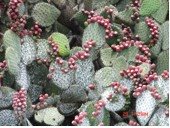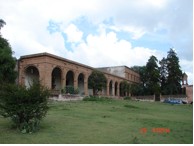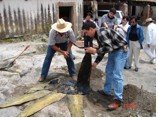 Xoconostle Mi Amor -Tuna Agria
Xoconostle Mi Amor -Tuna AgriaWith a slightly sour tang, xoconostle from the nahuatl language, is the oval fruit of a cactus . Found in the central region of Mexico its use varies from its addition in the famous Mole de Olla, stuffed with escamoles (black ant larvae), prepared in jams and jellies, refreshing “aguas”, flavoring pluque and as sweet dessert wine. In a land where everything has a use, this beautiful but spiny fruit has been used for mil-lennia. As part of Slow Foods commitment to preserving and supporting small arte-sanal growers our convivia was transported back in time to the Ex-Hacienda San Jose el Marquez located near the village of Santa Maria Amealco in the state Hi-dalgo.
 Construction began in the 1600’s by Marques del Villar del Aguila on a land grant from the Spanish King Philip III on an estate of almost 114,000acres (46,000 hectares). In its long life it has served as monastery, home and military fortress but with the land reform and revolution ,the hacienda has been reduced to a scant 50 acres (about 20 hectares), half of which is planted with xoconostle.. With the Spanish conquest also began deforesta-tion, introduction of foreign plants and animals, scant rainfalls causing desertifica-tion, causing a crippling effect on the traditional farm economy of the region. The 3 acres of buildings are in various states of disrepair, note the roofless chapel, but still a plucky young couple, Yunuén Carrillo Quiroz and her husband Gabriel Cortés García, whose family has owned the land since the 1940’s, have dedicated themselves to preserving and reclaiming the land.
Construction began in the 1600’s by Marques del Villar del Aguila on a land grant from the Spanish King Philip III on an estate of almost 114,000acres (46,000 hectares). In its long life it has served as monastery, home and military fortress but with the land reform and revolution ,the hacienda has been reduced to a scant 50 acres (about 20 hectares), half of which is planted with xoconostle.. With the Spanish conquest also began deforesta-tion, introduction of foreign plants and animals, scant rainfalls causing desertifica-tion, causing a crippling effect on the traditional farm economy of the region. The 3 acres of buildings are in various states of disrepair, note the roofless chapel, but still a plucky young couple, Yunuén Carrillo Quiroz and her husband Gabriel Cortés García, whose family has owned the land since the 1940’s, have dedicated themselves to preserving and reclaiming the land. 


Yunuen and Carlos have placed their “Xoxoc” brand of products into the marketplace and now give employment to 20 workers as well as going out to other communities where they teach what they have learned. They graciously invited us to their home and prepared a traditional Hacienda fiesta for our group that included the famous Barbacoa de Hoyo of the state of Hidalgo. The recipe calls for a yearling lamb to be wrapped in “pencas de maguey” ,leaves of the maguey plant,with a large kettle to collect the resultant broth, buried in a pit over a fire that is then covered and left for several hours to slowly cook. This method of cooking more commonly known as Pib cooking harkens back to Mayan times. The meat and the resultant broth are fragant ,from the maguey leaves, and the meat incredibly ten-der and juicy. Below the menu for the day:
For information on Xoconostle and the products that are prepared go to www.xoxoco.com.
Or by e-mail gabrielcortes@xoxoco.com & yunuencarillio@xoxoco.com.
For further information on IACP activities in Mexico contact Vice coordina-tor for Mexico Ruth T. Alegria at princetoncooking@aol.com. Come join us!

No comments:
Post a Comment